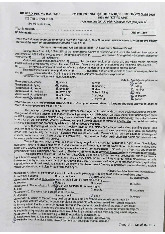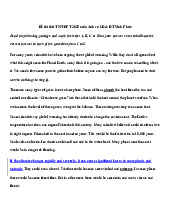



















Preview text:
Đề thi thử tốt nghiệp THPT Quốc gia môn tiếng Anh 2025 sở Thanh Hóa lần 2 có đáp án
Read the following leaflet and mark the letter A, B, C or D on your answer sheet
to indicate the option that best fits each of the numbered blanks from 1 to 6.
Travel Health Tips: Be safe on Your Trip!
Let's look at what you can do to stay safe while traveling abroad. ● Facts and figures:
Traveling abroad helps you understand (1) _______ cultures and meet other people with different
lifestyles. However, to have a safe trip, follow some tips below. ● Positive action!
1. Do your research: Read travelers' reviews and check with locals for information to find out the best
spots in the area. Try to (2) _______ some of the local language before you go.
2. Don't attract too much attention: Try not to look like a tourist. Be (3) _______ when taking out
money to buy things, especially on the street.
3. Don't carry too much cash: (4) _______ using notes, try to use credit cards as much as you can on
your trip. It's good to carry a small (5) _______ of local currency for everyday items.
4. Be aware of your (6) _______ : If someone near you is acting strange, leave the area immediately.
(Adapted from I-learn smart world) Question 1. A. others B. the others C. other D. another Question 2. A. take off B. carry out C. pick up D. put down Question 3. A. cautious B. positive C. sensitive D. confident Question 4. A. Instead of B. On account of C. In spite of D. Irrespective of Question 5. A. amount B. quality C. number D. sum
Question 6. A. communities B. habitats C. surroundings D. environments
Read the following advertisement and mark the letter A, B, C or D on your answer
sheet to indicate the option that best fits each of the numbered blanks from 7 to 12. PROTECTING OUR WILDLIFE
"Why should we care about the (7) _______ of wildlife conservation? Isn't it just another issue?" Are
these the thoughts that cross your mind when you hear about endangered species? But that's all going
to change! A global initiative has launched an inspiring campaign (8) _______ 'Wildlife Heroes,'
allowing you to be part of the solution! Join dedicated local communities in vital conservation
projects and appreciate working together to improve ecosystems. By volunteering your time and
skills, you can help (9) _______ endangered animals and restore their natural habitats.
You'll also have the chance to (10) _______ awareness about the importance of biodiversity and its
role in our lives. Whether you're passionate about reducing human-wildlife conflict or promoting
habitat restoration, there's a place for you in this (11) _______. Let's ensure a future where nature
thrives alongside us and creates a positive impact (12) _______ our planet.
Together, we can truly make a difference! (Adapted from Daily news) Question 7. A. urgent B. urgently C. urge D. urgency
Question 8. A. which called B. called C. was called D. calling Question 9. A. protect B. protecting C. protected D. to protecting Question 10. A. offer B. make C. raise D. do Question 11.
A. sustainable initiative ecosystem
B. sustainable ecosystem initiative
C. initiative sustainable ecosystem
D. ecosystem initiative sustainable Question 12. A. about B. to C. on D. in
Mark the letter A, B, C or D on your answer sheet to indicate the best
arrangement of utterances or sentences to make a meaningful exchange or text in
each of the following questions from 13 to 17. Question 13.
a. Emma: That sounds amazing! What have you learned about its impact on jobs?
b. Emma: Hi, Tom! It's been a while. You look really happy!
c. Tom: Thanks, Emma I just finished a course on AI. It's fascinating how it's changing everything. (Adapted from Global Success) A. a-c-b B. c-b-a C. c-a-b D. b-c-a Question 14. a. Mark: Why online learning?
b. Ann: I think, I'll try online learning.
c. Mark: What are you going to do to get IELTS 7.0?
d. Mark: I think online platforms are too expensive. I don't think I'll try them.
e. Ann: Teachers are all native speakers, and they have flexible schedules. (Adapted from Global Success) A. d-e-a-b-c B. c-e-d-b-a C. d-b-a-e-c D. c-b-a-e-d Question 15. Hi Helen,
a. Thanks so much for the article about the impact of social media on society you sent me last week.
b. It was great to read about how the media can shape public opinion.
c. I think we should discuss this topic further - what do you think?
d. I also appreciate the links to documentaries on media influence; they're much more insightful than
some of the articles I've been reading.
e. Mass media has changed over time, but I'm currently focused on my research on digital journalism. Write back soon, David (Adapted from Bright) A. d-b-a-c-e B. a-b-d-e-c C. a-c-d-b-c D. d-a-b-c-e Question 16.
a. Additionally, choosing eco-friendly products and supporting renewable energy sources, such as
solar or wind power, contributes to a greener planet.
b. Planting trees also helps reduce carbon dioxide levels and improves air quality.
c. Simple actions like reducing plastic use, recycling, and conserving water can make a significant difference.
d. It's important for individuals, businesses, and governments to work together to preserve natural
resources, reduce pollution, and combat climate change for future generations.
e. Protecting the environment is crucial for ensuring a healthy and sustainable future.
(Adapted from WWF and UN Environment Programme) A. e-c-b-a-d B. e-a-c-d-b C. d-e-a-c-b D. e-c-d-b-a Question 17.
a. However, despite this increase in opportunities, many fields still lack sufficient training programs, especially in smaller towns.
b. Career paths have evolved dramatically over the years, with more options available than ever before.
c. The rise of digital technologies has also created new jobs, especially in fields like IT, marketing, and online business.
d. This shift in the job market has led to a surge in specialized education and training, giving people a
chance to pursue various career interests.
e. As a result, more young people are seeking out non-traditional careers that allow for remote work and flexible schedules.
(Adapted from i-Learn Smart World) A. d-b-e-c-a B. b-c-d-a-e C. b-d-c-a-e D. b-d-e-c-a
Read the following passage about the risks of digital spending and mark the letter
A, B, C or D on your answer sheet to indicate the option that best fits each of the
numbered blanks from 18 to 22. BACK TO BASICS
Employees these days, who are expected to meet higher demands from their employers compared to
the past, (18) _______. This drive stems from a society increasingly focused on consumption and
material wealth. And even when we don't have the physical cash to pay for our purchases, we can
satisfy our desire to have the latest products by virtue of our trusty credit cards, (19) _______.
However, the only problem with this is that many people are being driven into serious debt by an
over-reliance on credit. The Internet has made it even easier for us to purchase expensive goods from
the comfort of our sitting-room sofa. Driven by such convenience, (20) _______. Banks and other
financial institutions also facilitate our spending urges, and for doing this, they are very much at fault.
Getting credit has become remarkably easy for consumers in today's market. (21) _______.
Once you've fallen into the trap of indebtedness, it is incredibly difficult to extract yourself from this
unpleasant financial situation. It is not only banks and credit card companies to blame; we engage in
self-destructive behavior. Working long hours and accumulating debt is not a path to happiness. (22)
_______. People need to evaluate their actions and shift their focus from materialism to the values of
the past. What truly matters is not material possessions but our relationships with family and friends.
In the end, it's not material things but the love of family and friends that defines real wealth.
(Adapted from Succeed in IELTS reading and vocabulary) Question 18.
A. being often motivated by the need to earn extra income
B. are often motivated by the need to earn extra income
C. having been motivated by the need to earn extra income
D. had been motivated by the need to earn extra income Question 19.
A. that encourage impulsive buying of unnecessary products
B. of which often lead to more financial stress and anxiety
C. which help us in effectively managing our financial choices
D. who often mislead us about financial stability issues Question 20.
A. many consumers tend to overspend on unnecessary items
B. The Internet was invented to help people to relax online
C. many people would prefer to shop in physical stores
D. going shopping on the Internet has become less attractive Question 21.
A. Consequently, many people end up getting into debt from buying things beyond their means
B. Accordingly, many people avoid getting into debt by buying their favourite luxurious items
C. Hence, every shopper always prefers using cash to stay in control of their shopping habits
D. Therefore, all customers improve their finances by carefully tracking their daily spending Question 22.
A. This misplaced pursuit is often believed to result in the neglect of true long-term value
B. This constant striving encourages people to strengthen family bonds and emotional health
C. This personal ambition often results in greater job opportunities and improved financial status
D. This effort usually helps people build a more luxurious lifestyle and gain social approval
Read the following passage about counter-urbanization and mark the letter A, B,
C or D on your answer sheet to indicate the best answer to each of the following
questions from 23 to 30.
Counter-urbanisation, the process of people migrating from urban areas to live in rural ones, has
become increasingly common in Vietnam in recent years. To illustrate, a number of people have
decided to leave bustling cities like Hanoi and Ho Chi Minh City for rural areas.
Counter-urbanisation is a new phenomenon with several benefits and potential problems for the whole nation.
Counter-urbanisation can bring positive effects on a country. Moving away from major cities can help
to alleviate issues such as overcrowding, traffic congestion and pollution in those urban areas.
What's more, it can even create opportunities for rural development as an increase in the rural
population can encourage significant investment in businesses and infrastructure in the countryside.
For instance, the growth of small enterprises and the improvement of transportation networks in rural
areas are often direct outcomes of this demographic shift. Additionally, local communities may
benefit from greater access to education, healthcare and employment opportunities as public and
private sectors respond to rising demand.
However, counter-urbanisation has also brought challenges to rural areas in some
cases. Many rural areas lack basic amenities such as medical facilities, schools and public
transportation, making it difficult for newcomers to settle in. This puts a strain on rural infrastructure
and services. At the same time, there is a real risk of environmental damage as more people move
into previously undeveloped areas. Deforestation, pollution, and other environmental issues can arise
as a result of increased human activities in these areas.
In conclusion, counter-urbanisation is a new trend that comes with advantages and disadvantages.
Therefore, local governments and communities will need to work together to effectively manage
public services, energy supplies and natural resources in order to promote economic extension and sustainable development. (Adapted from Bright 12)
Question 23. The word “phenomenon” in paragraph 1 could be best replaced by _______. A. difficulty B. solution C. event D. problem
Question 24. Which of the following is NOT mentioned in paragraph 2 as an advantage brought by
counter-urbanisation to local communities?
A. improved healthcare services B. better access to education
C. better environment protection D. more job opportunities
Question 25. The word “alleviate” in paragraph 2 is OPPOSITE in meaning to _______. A. cause B. reduce C. increase D. relieve
Question 26. The word “it” in paragraph 2 refers to _______. A. rural population B. traffic congestion C. counter-urbanisation D. pollution
Question 27. Which of the following best paraphrases the underlined sentence in paragraph 3?
A. In contrast, counter-urbanisation has been significantly beneficial to urban cities in some cases.
B. On the contrary, the challenges of counter-urbanisation are irrelevant to rural areas in certain cases.
C. Nevertheless, rural areas have faced difficulties due to counter-urbanisation in certain cases.
D. Nonetheless, counter-urbanisation has only brought benefits to rural areas in some cases.
Question 28. Which of the following is TRUE according to the passage?
A. Counter-urbanisation has gradually led to the complete abandonment of urban areas.
B. Counter-urbanisation helps reduce issues such as traffic and pollution in urban areas.
C. Many rural areas are adequately prepared to handle the sudden arrival of new residents.
D. Rural areas are becoming more populated than urban areas due to counter-urbanisation.
Question 29. In which paragraph does the writer discuss the challenges faced by rural areas due to counter-urbanisation? A. Paragraph 1 B. Paragraph 2 C. Paragraph 3 D. Paragraph 4
Question 30. In which paragraph does the writer propose a solution to manage the effects of counter-urbanisation? A. Paragraph 4 B. Paragraph 3 C. Paragraph 1 D. Paragraph 2
Read the following passage about the importance of green design in construction
and mark the letter A, B, C or D on your answer sheet to indicate the best answer
to each of the following questions.
[I] There has, in recent years, been an outpouring of information about the impact of buildings on the
natural environment. [II] Information that explains and promotes green and sustainable construction
design strives to convince others of its efficacy and warns of the dangers of ignoring the issue. [III]
However, these documents hardly offer any practical advice to practitioners, such as those designing
mechanical and electrical systems for a building, on how to utilize this knowledge effectively in their work. [IV]
While the terms green and sustainable are often viewed as synonymous, they represent different
concepts. Sustainability is defined as minimizing the negative impacts of human activities on the
natural environment, particularly those that have long-term and permanent effects. Some elements of
green design may also be sustainable, such as those that reduce energy usage and pollution, while
others, like ensuring indoor air quality, may be considered green even if they have no direct influence.
Although many advocates promote green construction within the architectural industry and can cite
numerous reasons for why buildings should be designed sustainably, this is not enough to bring green
construction to fruition. The driving force behind whether a building is constructed with minimal
environmental impact ultimately comes down to the owner; that is, the individual financing the
project. If the owner considers green design unimportant or of secondary importance, it is highly
likely that it will not be integrated into the design process.
The commissioning process is a key factor in ensuring that the building meets the owner's
expectations regarding design, budget, and risk management. At the predesign stage, the owner's
objectives, criteria, and the type of design they envision are discussed and documented, providing a
solid foundation for the design team. Owners who skip this process or overlook green
issues often encounter significant challenges once their building is operational.
Although materials and equipment are installed as planned, the owner may later realize that
operational and maintenance costs are higher than necessary, and that occupants are dissatisfied.
These factors ultimately lead to increased ownership costs as well as a greater environmental impact.
(Adapted from TOEFL Reading Tests)
Question 31. Where in paragraph 1 does the following sentence best fit? “This lack of guidance is
challenging for professionals to integrate sustainability into their designs.” A. [IV] B. [II] C. [III] D. [I]
Question 32. The word “convince” in paragraph 1 is OPPOSITE in meaning to _______. A. influence B. prevent C. demonstrate D. encourage
Question 33. The word “those” in paragraph 2 refers to _______. A. effects B. elements C. activities D. concepts
Question 34. According to paragraph 2, which of the following is NOT a characteristic of green design? A. Reducing pollution B. Causing permanent effects C. Ensuring indoor air quality D. Reducing energy usage
Question 35. Which of the following best summarises paragraph 3?
A. Sustainable buildings are built regardless of the owner's preferences and priorities.
B. Green construction relies on regulations, often ignoring the owner's preferences.
C. The impact of green design often truly depends on project budget and timelines.
D. The owner's priorities greatly affect whether green design is included in projects.
Question 36. The phrase “comes down to” in paragraph 3 could be best replaced by _______. A. bring about B. depend on C. take on D. keep up
Question 37. Which of the following is NOT true according to the passage?
A. The commissioning process ensures that the owner's goals are achieved.
B. The owner's involvement is crucial for implementing green design.
C. Green design documents generally offer practical advice for designers.
D. Green and sustainable design are considered interchangeable in construction.
Question 38. Which of the following best paraphrases the underlined sentence in paragraph 4?
A. Owners ignoring green design or the process often face big problems when using their buildings later.
B. Owners that care about green issues rarely need help operating their construction sites effectively later on.
C. Owners skipping green topics may benefit from lower design risks and shorter construction time in cities.
D. Owners who follow the process usually reduce the cost of building materials and design fees quickly.
Question 39. Which of the following can be inferred from the passage?
A. To apply green design successfully, owners must plan finances well and commit to long-term sustainability goals.
B. Green design is often seen as a luxury only a few owners and developers can actually afford to use.
C. Green design works well without big costs, if the team truly focuses on using sustainable practices.
D. Ignoring full green design during construction leads to lower future costs and worse long term environmental effects.
Question 40. Which of the following best summarises the passage?
A. Successful green design in every building relies on the integration of sustainable practices, with
the owner's financial backing being essential to achieving these goals.
B. Green construction completely depends on the owner's financial commitment and early-stage
planning to minimize environmental impact and operational costs.
C. Green design requires the owner's prioritization and financial support, along with a structured
commissioning process to ensure successful implementation.
D. For green design to be effective, it needs full owner commitment and detailed planning to reduce
long-term environmental and cost-related issues.




